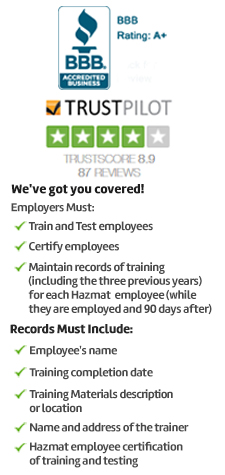
DOT HAZMAT Shipping Training

This course is made to address all basic Hazmat carrier shipping requirements including UPS and FedEx . The training for students and working personnel is ideal for both initial and subsequent training of workers associated with transportation of hazardous materials as mandated by the Department of Transportation (DoT).
NOTE: If you send hazardous materials by air, then you can join our IATA DGR (Dangerous Goods Regulations) course.
Governing regulations
This online DOT Hazmat Transportation General & Security Awareness, and Function Specific course is formulised to satisfy the training requirements as prescribed by Part 172, Subpart H of the Hazardous Materials Regulations.
Course Overview
This online training course has been conceptualised to make students familiar with the principles of the Hazardous Materials Regulations (HMR). There are a set of training modules which will help students to know how to handle, pack, mark, label, placard and transport hazardous materials. The course guide will also give an overview of the security needs emphasised in the HMR, and deliver guidance and suggestions to comply with those requirements.
Who Must Take this Course?
According to the DoT, all employees who are entrusted with the responsibility of handling or shipping hazardous materials should have experience and expertise along with required certification by their employer to perform such dangerous works. For those joining as hazardous items handlers should work under the supervision of experienced personnel for the initial 90 days to gain knowledge and skills.
Course Format
Students who join us for the DOT Hazmat Transportation General Awareness, Security Awareness & Function Specific course are provided with content, audio, graphics, self-check questions, before appearing for the final exam.
Upon successful completion each student will receive Hard copy of completion certificate and can print a wallet card
Continuing education credits?
All students will receive 0.3 CEUs (or 3 CMEs) from Compliance Training Online® after completing the course.
Topics Covered
- About This Course
- Course Objectives
- Introduction to DOT Hazmat General Awareness and Security Training
- Applicability
- Incidents and Statistics
- Hazardous Materials Regulations (HMR)
- Regulatory Agencies
- Legal
- Penalties
- Responsibilities
- How to Use the HMR
- Training
- Training Topics
- Training Requirements
- Training Programs
- Training Records
- Hazardous Materials Table (HMT)
- Columns of the HMT
- Appendix A
- Appendix B
- How to Use the HMT
- Hazard Classes
- Class 1 Explosives
- Division 1.1
- Division 1.2
- Division 1.3
- Division 1.4
- Division 1.5
- Division 1.6
- Class 2 Gases
- Division 2.1—Flammable gas
- Division 2.2—Non-flammable, non-poisonous, compressed gas
- Division 2.3—Poisonous gas
- Class 3 Flammable Liquids
- Flammable liquids
- Combustible liquids
- Class 4 Flammable Solids
- Division 4.1—Flammable solids
- Division 4.2—Spontaneous combustible material
- Division 4.3—Dangerous when wet material
- Class 5 Oxidizing Substances and Organic Peroxides
- Division 5.1—Oxidizers
- Division 5.2—Organic peroxides
- Class 6 Toxic and Infectious Substances
- Division 6.1—Poisonous/toxic materials
- Division 6.2—Infectious substances
- Class 7 Radioactive Material
- Class 8 Corrosives
- Class 9 Miscellaneous
- ORM-D
- Materials of Trade
- Class 1 Explosives
- Packaging
- Packaging Responsibilities
- Package Inspections
- Determining Appropriate Packaging
- Types of Packagings
- UN Standard Packaging Marking
- Bulk Packaging
- Non-Bulk Packaging
- General Packing Requirements
- Exceptions—Limited and Small Quantities
- Packaging
- Exceptions—Agricultural Products
- Exceptions—MOT
- Exceptions—Lab Packs
- Damaged or Leaking Packages
- Overpacks
- DoD Packaging and Special Permits
- Reusable Packaging
- Marking, Labeling, and Placarding
- Markings
- Non-Bulk Markings
- Limited Quantities
- Bulk Markings
- Radioactive Material Markings
- Content-Specific Markings
- Labeling
- Exceptions
- Radioactive Materials
- Mixed and Consolidated Packagings
- Label Specifications
- Placarding
- Exceptions
- Prohibited Placarding
- Placarding Tables
- Dangerous Placard
- Placarding Subsidiary Hazards
- Placard Exceptions
- Placard Specifications
- Markings
- Shipping Papers
- Shipping Paper Exceptions
- Preparation of Shipping Papers
- Basic Description
- Additional Information
- Emergency Response Information
- Certification
- Retention
- Incident Reporting
- Telephone Notification
- Written Reports
- Lithium Batteries
- Lithium Battery Classification
- Packaging
- Exceptions for Small Lithium Cells or Batteries
- Packaging, Labeling, and Markings
- Air Transportation of Lithium Cells and Batteries
- Additional Exceptions
- Security Awareness
- Security Plans
- Security Plan Requirements
- Security Plan Elements
- Security Training
- Potential Targets
- Potential Threats
- En Route Security
- Security Assessment
- Personnel Security
- Employee Background Checks
- Unauthorized Access
- Security Plans
- Summary
- Additional Resources
- Exam

 NEBOSH CERTIFICATE
NEBOSH CERTIFICATE NEBOSH DIPLOMA
NEBOSH DIPLOMA IOSH
IOSH SAFETY DIPLOMA
SAFETY DIPLOMA CPD UK
CPD UK ROSPA UK
ROSPA UK FOOD SAFETY
FOOD SAFETY 



